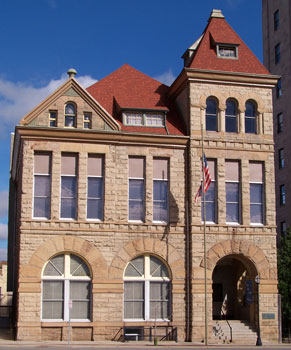Soldiers & Sailors
Soldiers and Sailors Memorial Building
The Soldiers and Sailors Memorial Building has been open to the public since 1889. The building exists because of an Ohio Revised Code Law passed by legislature in 1887. The Mansfield Memorial Building was the first memorial building to be built and is the last standing, virtually unchanged from its construction in 1887 – 1889. In April of 1889, the building opened to the public and veterans. The purpose of the building was to have a permanent meeting place for the GAR (Grand Army of the Republic), or Civil War veterans, similar to what the Legions and Post are today.
The cost of the building with an 857-seat opera house was around $65,000 – a very large amount for 1888. The public library partnered to help raise the funds, which were bonds for the construction. In the original law there was also a stipulation to house a museum of historical artifacts for the military.
The building, as its stands today, has not changed much from when it opened. The opera house behind the building was the income producer for the entire building, so as not to put a burden on the community. The building opened to much fanfare, as seen in the photo with all Civil War veterans standing in front of the building. The chairs used in the GAR hall numbered 100 – 97 of them still remain and are used throughout the building.

In 1925 the opera house was renovated a new Wurlitzer theater organ was installed, the theater was modernized, and it was renamed the Madison Theater. In February 1929, the opera house burned to the ground, but the firewall saved the front part that was the Memorial Building. Within a month of the fire, the board of trustees decided to rebuild a new theater. The second theater was also named the Madison Theater. Prior to the Ohio Theater in 1928, the Madison Theater was the largest in Mansfield.
The second Madison Theater’s was discontinued in 1986 because of a myriad of problems, including wanting to save the Ohio Theater instead of the Madison. The building is still used by veterans’ organizations for storage and a meeting space. To this day the building is not supported by city, state, or county funds and survives on private donations. The board of trustees administers the workings of the Memorial Building, as it did when it opened.

Mansfield Memorial Museum

The Mansfield Memorial Museum is the brainchild of Edward Wilkinson, a Civil War veteran. After the war, his uncle Robinson (who built Oak Hill Cottage and then sold it to Dr. Jones) had a silver mine in Mexico. He asked Edward and his brother Sam to help run the mine.
Edward was always interested in natural history and found a plethora of new and wondrous animal and plants he collected for many museums and institutions on the east coast. He collected for the Smithsonian Institute, Peabody Museum, Carnegie Museum, New York Natural History Museum, and the Field Museum in Chicago. In the Smithsonian Institute, they still have and use his botanical specimens. Edward’s influence in natural history was far reaching, and three (should be five species) are named for him. In 1902 a Hawthorn Tree was named for him by the Botanical Society of America. (It was later found that it was a sub-species, and the name was removed.) In 2022, on the 100th anniversary of this naming, we are going to plant that Hawthorn species on the Memorial property.
Edward also helped collected specimens for Cope, a famous paleontologist studying a primitive lizard from Mexico. Edward sent in crates of the lizards for study.
The original collections of the museum were eclectic and numerous in their variety. Edward donated the museum to the GAR, and it eventually came under the jurisdiction of the board of trustees. The museum was renovated in 1925 and, unfortunately, all the early records, notes, and files were discarded. The museum stayed open until 1955. Over 44 years the museum stayed closed, but not inactive – for over the period of time after it closed, many items that were in the museum disappeared never to be seen again.


The museum was rediscovered in 1997 and was opened to the public again in 1999. Since that time, many new and historic items for the exhibits have been added either through donations or loans from private individuals. The museum has saved the Brinkerhoff archive, News Journal archive, GM archive, WCLW Radio Station record archive, and much more. Many film, photos, and recordings are saved for future enjoyment.
The Mansfield Memorial Museum’s claim to fame is ELEKTRO, the Westinghouse robot of the 1939 New York World’s Fair. The museum’s collections range from birds, animals, Johnny Appleseed, Native American, African American, industry, military, early Mansfield history, African, Malaysian, Polynesian, 600 1∕72 scale model planes, 432 1∕35 scale armored vehicles, ELEKTRO, and much more.
There is something of interest for everyone – come and visit.
We are also looking for volunteers to help in research and to help take visitors through the museum.

























